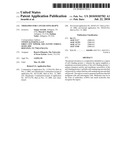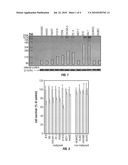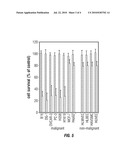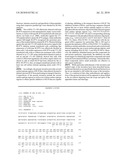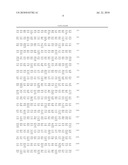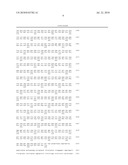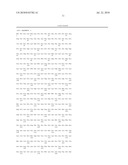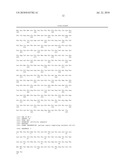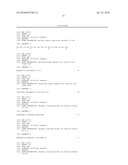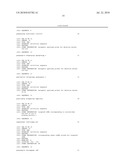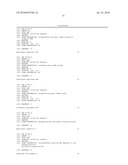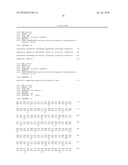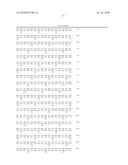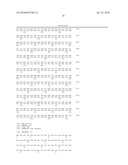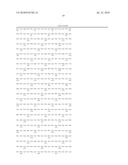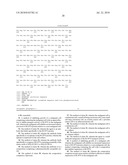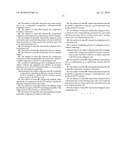Patent application title: Therapies For Cancer Using RLIP76
Inventors:
Sanjay Awasthi (Arlington, TX, US)
Sanjay Awasthi (Arlington, TX, US)
Sharad S. Singhal (Arlington, TX, US)
Sharad S. Singhal (Arlington, TX, US)
Sushma Yadav (Arlington, TX, US)
Assignees:
Board of Regents, The University of Texas System
IPC8 Class: AA61K9127FI
USPC Class:
424450
Class name: Drug, bio-affecting and body treating compositions preparations characterized by special physical form liposomes
Publication date: 2010-07-22
Patent application number: 20100183702
Claims:
1-30. (canceled)
31. A method of inhibiting growth of a malignant cell comprising contacting the malignant cell with an agent effective to inhibit transport activity of RLIP76 in the malignant cell, wherein the malignant cell exhibits an increased expression level of RLIP76 protein relative to a non-malignant cell.
32. The method of claim 31, wherein the agent is an antibody that binds specifically to the RLIP76 protein.
33. The method of claim 32, wherein the antibody binds specifically to an epitope on the RLIP76 protein, wherein the epitope is expressed on the cell surface.
34. The method of claim 32, wherein the antibody binds specifically to a region of RLIP76 consisting essentially of the amino acids of SEQ ID NO:3 or SEQ ID NO:4.
35. The method of claim 32, wherein the antibody is in a composition comprising a pharmaceutically acceptable carrier.
36. The method of claim 35, wherein the composition comprises a liposome.
37. The method of claim 31, wherein the malignant cell is a melanoma cell, a small cell lung carcinoma cell, a non-small cell lung carcinoma cell, an ovarian cancer cell, a prostate cancer cell or an adenocarcinoma cell.
38. The method of claim 31, wherein the malignant cell is a melanoma cell.
39. The method of claim 31, wherein the malignant cell is in a subject.
40. The method of claim 31, wherein the malignant cell is in a human subject.
41. The method of claim 31, wherein the agent is a small molecule antagonist of the RLIP76 transport activity.
42. A method of inhibiting growth of a malignant cell, wherein the malignant cell exhibits an increased expression level of RLIP76 protein relative to a non-malignant cell, the method comprising contacting the cell with a composition that inhibits expression of RLIP76.
43. The method of claim 42, wherein the composition comprises an anti-sense nucleic acid that is effective to inhibit expression of RLIP76 in the malignant cell.
44. The method of claim 43, wherein the anti-sense nucleic acid is in a composition comprising a pharmaceutically acceptable carrier.
45. The method of claim 44, wherein the composition comprises a liposome.
46. The method of claim 44, wherein the composition comprises a proteoliposome comprising an RLIP76 protein.
47. The method of claim 42, wherein the malignant cell is a melanoma cell, a small cell lung cancer cell, a non-small cell lung cancer cell, an ovarian cancer cell, a prostate cancer cell or an adenocarcinoma cell.
48. The method of claim 42, wherein the malignant cell is a melanoma cell.
49. The method of claim 42, wherein the cell is in a subject.
50. The method of claim 42, wherein the cell is in a human subject.
51. The method of claim 42, wherein the composition comprises a double stranded siRNA molecule that is effective to inhibit expression of RLIP76 in the malignant cell.
52. A method of inhibiting growth of a malignant cell in a subject, wherein the malignant cell exhibits an increased expression level of RLIP76 protein relative to a non-malignant cell, said method comprising:administering to the subject a pharmaceutically acceptable composition comprising an effective amount of an anti-RLIP76 antibody to inhibit RLIP76 transport activity when bound to RLIP76 in a cell.
53. The method of claim 52, wherein the antibody binds specifically to an epitope on the RLIP76 protein, wherein the epitope is expressed on the cell surface.
54. The method of claim 52, wherein the antibody binds specifically to a region of RLIP76 consisting essentially of the amino acids of SEQ ID NO:3 or SEQ ID NO:4.
55. The method of claim 52, wherein the pharmaceutically acceptable composition comprises a liposome.
56. The method of claim 52, wherein the pharmaceutically acceptable composition comprises a proteoliposome comprising an RLIP76 protein.
57. The method of claim 52, wherein the malignant cell is a melanoma cell, a small cell lung carcinoma cell, a non-small cell lung carcinoma cell, an ovarian cancer cell, a prostate cancer cell or an adenocarcinoma cell.
58. The method of claim 52, wherein the malignant cell is a melanoma cell.
59. A method of inhibiting growth of a malignant cell in a subject comprising:administering to the subject a pharmaceutically acceptable composition comprising an effective amount of an anti-sense nucleic acid that is effective to inhibit expression of RLIP76 in the malignant cell.
60. The method of claim 59, wherein the anti-sense nucleic acid is complementary to an mRNA that encodes SEQ ID NO:22.
61. The method of claim 59, wherein the pharmaceutically acceptable composition comprises a liposome.
62. The method of claim 59, wherein the pharmaceutically acceptable composition comprises a proteoliposome comprising an RLIP76 protein.
63. The method of claim 59, wherein the malignant cell is a melanoma cell, a small cell lung cancer cell, a non-small cell lung cancer cell, an ovarian cancer cell, a prostate cancer cell or an adenocarcinoma cell.
64. The method of claim 59, wherein the malignant cell is a melanoma cell.
Description:
CROSS-REFERENCES TO RELATED APPLICATIONS
[0001]This application is a continuation of U.S. application Ser. No. 11/264,910, filed Nov. 2, 2005, which is a continuation-in-part of prior U.S. application Ser. No. 10/714,506, filed Nov. 13, 2003, which claims the benefit of U.S. Provisional Patent Application No. 60/425,917, filed Nov. 13, 2002, all of which are incorporated herein by reference for all purposes. This application is also a continuation-in-part of prior U.S. application Ser. No. 10/713,578, filed Nov. 13, 2003, which claims the benefit of U.S. Provisional Patent Application No. 60/425,814, filed Nov. 13, 2002, both of which are incorporated herein by reference for all purposes.
REFERENCE TO A SEQUENCE LISTING
[0003]This application incorporates by reference sequence listing material included on computer readable form and identified as 124263-1040 RLIP.ST25.txt saved on Nov. 2, 2005, in ASCII readable form.
BACKGROUND OF THE INVENTION
[0004]The present invention relates to improved anti-cancer therapies, particularly one targeted towards cells expressing high levels of a ral interacting protein, RLIP76.
[0005]Current therapies for human cancers are generally unsatisfactory because of a high rate of failure and excessive side-effects. Side effects are generally significant and result, in part, because few current therapies are targeted to cancerous cells alone. There remains a need to identify targeted therapies that eliminate only cancerous cells and not healthy cells.
SUMMARY OF THE INVENTION
[0006]The present invention solves problems associated with current therapies for cancerous cells or those that undergo uncontrolled cell growth (e.g., cancerous, tumorigenic and malignant cells). In particular, the present invention provides compositions for inhibiting and/or depleting RLIP76.
[0007]As provided herein, RLIP76 is a membrane associated protein and a critical as well as predominant regulator of transport in cancerous cells or those undergoing uncontrolled cells growth. Targeting therapies against RLIP76 directly effects RLIP76 transport activity and reduces the number and/or potency of such cells undergoing uncontrolled cell growth in subjects having such uncontrolled and growing cells.
[0008]The present invention provides for compositions that target RLIP76 and reduce the number and/or potency of cells undergoing uncontrolled cell growth. Compositions comprise a region homologous to a portion of a ralA binding protein 1, wherein the region neighbors a membrane-associated portion of the ralA binding protein 1, reduces transport activity and membrane association of ralA binding protein 1 and kills cells undergoing uncontrolled cell growth in a subject that has cells undergoing uncontrolled cell growth.
[0009]Compositions of the present invention include an internal peptide region of RLIP76 to be used as bait in screens of chemical libraries for synthetic and naturally occurring organic chemicals and compounds with an ability to reduce the number and/or potency of cells undergoing uncontrolled cell growth. The identified chemicals and compounds are those acting as specific inhibitors of RLIP76 activity (e.g., found to reduce the number and/or potency of cells undergoing uncontrolled cell growth). As such, the present invention provides for compositions that are improved therapies for cancers, malignancies, and tumorigenic or uncontrolled growth cells that express RLIP76.
[0010]In one form, the present invention provides for a region recognizing a ralA binding protein 1, wherein the region further comprises SEQ ID NO:28 and modified variants thereof.
[0011]In other forms, the present invention provides for compositions and methods of using such compositions as SEQ ID NO: 3 to SEQ ID NO:19 and SEQ ID NO:21. Such compositions, in various forms to be used to identify compounds as medicines for cancers, malignancies and tumors and for reducing the number and/or potency of cells undergoing uncontrolled cell growth.
[0012]Those skilled in the art will further appreciate the above-noted features and advantages of the invention together with other important aspects thereof upon reading the detailed description that follows in conjunction with the drawings.
BRIEF DESCRIPTION OF THE DRAWINGS
[0013]For more complete understanding of the features and advantages of the present invention, reference is now made to the detailed description of the invention along with the accompanying figures, wherein:
[0014]FIG. 1 depicts comparison of RLIP76 levels in cultured malignant vs. non-malignant cells;
[0015]FIG. 2 depicts effects of pre-immune IgG (dark bars) and anti-RLIP76 IgG (white bars) (37 μg/ml final) on cell survival as determined by MTT assay;
[0016]FIG. 3 depicts a depletion of RLIP76 expression in malignant and non-malignant cells using RLIP76 si-RNA;
[0017]FIG. 4 depicts a time dependent effect of RLIP76 si-RNA in malignant and non-malignant cells;
[0018]FIG. 5 depicts MTT assays for malignant and non-malignant cells performed 48 hours after treatment with si-RNA in which grey bars show scrambled si-RNA white bars show RLIP76 si-RNA; and
[0019]FIGS. 6 A and B-J depict antineoplastic effects of RLIP76 inhibition or depletion in mouse melanoma in which (A) shows tumor measurements pooled from control animals, including PBS, pre-immune IgG, scrambled siRNA antisense injection (circle), versus treated animals, including anti-RLIP76 IgG, RLIP76 siRNA, RLIP76 phosphorothioate antisense injection (square), and (B)-(J) show photographs of representative animals taken at eight days after treatment.
[0020]FIG. 7 is a diagram of a method of identifying inhibitors or RLIP76 transport activity.
DETAILED DESCRIPTION OF THE INVENTION
[0021]Although making and using various embodiments of the present invention are discussed in detail below, it should be appreciated that the present invention provides many inventive concepts that may be embodied in a wide variety of contexts. The specific aspects and embodiments discussed herein are merely illustrative of ways to make and use the invention, and do not limit the scope of the invention.
[0022]In the description which follows like parts are marked throughout the specification and drawing with the same reference numerals, respectively. The drawing figures are not necessarily to scale and certain features may be shown exaggerated in scale or in a somewhat generalized or schematic form in the interest of clarity and conciseness.
[0023]The following are abbreviations that may be used in describing the present invention: RLIP, ral interacting protein; MDR, multi-drug resistance; GS-E, glutathione-electrophile conjugates; phenyloin, PHE; carbamazepine, CBZ.
[0024]Current antineoplastic therapies for human malignancies are limited by the occurrence of significant normal tissue toxicities due to inherent relatively non-specific genotoxic or signaling effects. Attempts to improve antineoplastic therapies have focused on identifying targets which are preferentially expressed in cancer cells, which when inhibited cause apoptosis in malignant cells while sparing cells of normal tissues. Delineation of differentially expressed signaling proteins that are responsible for un-regulated growth and suppression of normal apoptotic pathways has led to the identification of numerous potential targets. While new agents have emerged, such as antibodies including rituximab (anti-CD20 antibody for lympho-proliferative disorders), trastuzumab (anti-Her-2/neu antibody for breast cancer) and small molecules including imatinib mseylate (Bcr-Abl kinase inhibitor for chronic myelogenous leukemia) and erlotinib (tyrosine kinase inhibitor for a variety of solid tumors), their overall efficacy remains limited, because of their limited effectiveness in only a small fraction of patients with such malignancies or because of clonal selection of cancer cells inherently refractory to such therapies. Thus, development of new targeting molecules and discovery of new targets remains critical.
[0025]RLIP76 (also referred to herein as RALBP 1) represents a novel target for cancer therapy not only because of its involvement in the rate-controlling step in glutathione (GSH)-mediated metabolism of electrophilic or oxidant chemicals often used as anti-neoplastic agents, but also because of its apparent linkage to key signaling pathways known to be crucial for the survival, proliferation, and motility of malignant cells. The present inventors have recently demonstrated that lack of RLIP76 in knockout mice leads to loss of nearly 4/5 of total GSH-conjugate (GS-E) as well as anthracycline-transport activity, and widespread changes in GSH-linked antioxidant enzymes (as disclosed, e.g., in Awasthi S, et al. Cancer Res 2005; 65:6022-8). RLIP76.sup.-/- mice develop a characteristic sensitivity to stress, particularly to ionizing radiation. These and other studies by the inventors in cell culture systems implicate RLIP76 as a part of stress-defenses (as disclosed, e.g., in Yang, et al., J Biol Chem 2003; 278:41380-88). In particular, the inventors have determined that inhibition of RLIP76 transport function using antibodies to a cell-surface epitope or depletion of RLIP76 using si-RNA uniformly causes apoptosis in a variety of histological types of cancers (as disclosed, e.g., in Awasthi, et al., Int J Oncol 2003; 22:713-20; Awasthi, et al., Int J Oncol 2003; 22:721-32; Yadav, et al., Biochemistry 2004; 43:16243-53; Struckler, et al., Cancer Res 2005; 65:991-8).
[0026]The present invention provides clinical applicability of RLIP76 as a target for anti-cancer therapy. The present invention confirms that there is a greater dependence on RLIP76 in cancer cells, due to greater expression of the protein in such cells. The present invention shows that this dependence translates to a greater susceptibility of cancer cells to agents that deplete RLIP76; hence, RLIP76 is a powerful target a broad-spectrum anti-cancer therapy.
[0027]Anti-RLIP agents, those that reduce and inhibit protein function or deplete expression of the protein are provided herein. Such agents include anti-RLIP76 IgG, si-RNA and anti-sense DNA oligonucleotides. With the present invention, it is demonstrated that because RLIP76 is expressed to a greater degree in malignant cells and RLIP76 inhibition or depletion causes preferential toxicity towards malignant cells, anti RLIP agents exert significant antineoplastic effects in the malignant cells.
[0028]The inventors, Sanjay Awasthi and Sharad S. Singhal, of the present invention have recently described a novel non-ABC transporter that appears to be multispecific as a Ral interacting protein (see U.S. application Ser. No. 10/714,506; U.S. application Ser. No. 10/713,578; each incorporated herein by reference). As used herein, this transporter is referred to RLIP76 or RalBP1. The official human genome name for the protein is RALBP1 (SEQ ID NO:1; and SEQ ID NO:22 for the coding sequence). RLIP76 is a modular multifunctional and modular protein found ubiquitously in many species from Drosophila to humans. It is encoded in humans on chromosome 18p11.3 by a gene with 11 exons and 9 introns. The protein product, also known as ralA binding protein 1, is typically a 76 kDa (SEQ ID NO:2; and SEQ ID NO:23 for the coding sequence) protein; however, splice-variants including a 67 kDa peptide and a longer 80 kDa or 102 kDa peptide, cytocentrin, have also been identified.
[0029]Malignant cells contain a greater quantity of antigenically detectable RLIP76 as shown in the Table and in FIG. 1 in which RLIP76 obtained from various cell lines (of different origin) was quantitated (not all purification data shown). The Table and FIG. 1 shows there to be greater RLIP76 in malignant cells as compared with non-malignant cells. Total RLIP76 protein was purified from membrane fraction of several malignant cell lines, including human small cell lung cancer (SCLC; H1618), non-small cell lung cancer (NSCLC; H358), ovarian (OVCAR-3), breast (MCF-7), prostate (PC-3), liver (HepG2), melanoma (DG-1), mouse melanoma (B16-F1) and non-malignant human cell lines of endothelial (HUVEC, HLMVEC), epithelial (HLBEC), and aortic smooth muscle (HAVSMC) origin. Purification folds of 120 to 153 were observed, and single protein band of intact RLIP76 were seen in SDS PAGE, which were recognized by purified polyclonal rabbit-anti-human RLIP76 antibodies in Western blot analyses. Antibodies were not non-cross-reactive with other proteins including PgP or MRP-1. No significant contamination was observed in the Western blots. Representative purified protein data, quantified by ELISA, are shown in TABLE 1. Western blot analyses of crude membrane fraction from each cells with lanes loaded with equal amount of crude protein (200 μg) are shown in FIG. 1. RLIP76 was purified by DNPSG-affinity as described previously by the inventors (Singhal, et al., Int J Oncol 2003; 22:365-75). Briefly, cells were pelleted and washed with a balanced salt solution (138 mM NaCl, 5 mM KCl, 0.3 mM KH2PO4, 0.3 mM Na2HPO4, 4 mM NaHCO3, and 5.6 mM glucose, pH 7.4). Cells were lysed in a lysis buffer (10 mM Tris-HCl, pH 7.4, containing 1.4 mM BME, 0.1 mM PMSF, 0.05 mM BHT and 0.1 mM EDTA) followed by sonication and recovery of pellets in lysis buffer containing 0.25% polidocanol. After incubation for 4 hours in the cold, samples were centrifuged and supernatants applied to DNP-SG Sepharose-affinity column. Homogenous RLIP76 was obtained using methods known to one of ordinary skill in the art.
TABLE-US-00001 TABLE RLIP76 Protein and transport activity in malignant and non-malignant cell lines. RLIP76 Protein Transport Activity μg/108 % of total (pmol/min/mg) cells protein DOX DNP-SG MALIGNANT CELLS B16 (mouse melanoma) 71 ± 6 0.8 443 ± 34 1796 ± 145 DG-1 (human melanoma) 63 ± 5 0.8 384 ± 28 1562 ± 112 OVCAR-3 (human ovary) 53 ± 3 0.7 298 ± 23 1194 ± 122 PC-3 (human prostate) 46 ± 3 0.6 211 ± 26 893 ± 66 H358 (human lung, NSCLC) 36 ± 3 0.6 180 ± 15 695 ± 56 H1618 (human lung, SCLC) 32 ± 3 0.5 96 ± 12 361 ± 41 MCF-7 (human breast) 15 ± 1 0.2 36 ± 3 105 ± 7 HepG2 (human liver) 17 ± 1 0.3 55 ± 5 167 ± 14 NON-MALIGNANT CELLS HLMVEC (human lung endothelium) 19 ± 2 0.3 40 ± 5 136 ± 14 HLBEC (human lung epithelium) 22 ± 2 0.4 46 ± 4 150 ± 20 HAVSM (human aorta smooth muscle) 15 ± 1 0.3 40 ± 6 125 ± 10 HUVEC (human umbilical endothelial) 14 ± 1 0.2 36 ± 4 113 ± 12
[0030]Transport activity of RLIP76 is greater in malignant cells as determined by membrane vesicles prepared from plasma membrane fractions from each cell line, enriched for inside-out vesicles (IOVs) by wheat-germ agglutinin affinity chromatography as previously described by the inventors (see, e.g., Awasthi, et al., Int J Cancer 2004; 112:934-42). Results of measurements of ATP-dependent transport of 14C-doxorubicin (DOX) as well as 3H-dinitrophenyl S-glutathione (DNP-SG) using a standardized 96 well-plate transport assay revealed greater transport of both substrates in cells containing greater amount of RLIP76 protein. The Table shows the general correlation between RLIP76 protein level and transport activity. The greatest transport activity was found in melanoma cells with transport activity greater than in malignant than non-malignant cells. Low expression of RLIP76 in MCF-7 and HepG2 correlated with lower transport rate in the crude-membrane vesicles. Total DOX or DNP-SG transport rate correlated with either RLIP76 protein amounts (Table) or RLIP76 ATPase activity (data not shown). ATPase activity was measured using aliquots of protein fraction containing 1 to 10 μg protein added to a 0.5 mL reaction mixture (50 mM Tris-HCl pH 7.4, 10 mM MgCl2, 2 mM EGTA, 0.8 mM sodium phosphate, 2.8 mM β-mercaptoethanol, and 1 mM ouabain) that incubated for 5 minutes at 37° C. Each reaction was initiated with 1.6 mM γ-32P-ATP with or without 0.12 mM DNP-SG or 0.01 mM DOX. After 60 minutes each reaction was terminated by addition of a 2.5 ml cold mixture of 1 M perchloric acid and 5% ammonium molybdate in water (4:1) followed by extraction with a 2.5 mL mixture of isobutanol-benzene (1:1). Radioactivity was quantified in the organic phase to determine cleaved terminal phosphate. RLIP76 activity was calculated by subtracting background counts obtained in the absence of protein from those obtained in the presence of protein. RLIP76 activity was calculated by subtracting the activity seen in the absence of DOX or DNP-SG from that seen in its presence. Each assay was performed in triplicate.
[0031]Crude membrane vesicles (inside-out vesicles or IOVs) were prepared from non-malignant cells (HAVSMC, HLBEC, HLMVEC and HUVEC) and cancer cells (SCLC, NSCLC, DG-1 human melanoma, mouse B16 melanoma, MCF7, HepG2, PC-3 and OVCAR-3) identified in the Table using procedures known in the art (see, e.g., Awasthi, et al., Clin Invest 1994; 93:958-65; Awasthi, et al., Biochemistry 2000; 39:9327-34). Transport studies in IOVs were performed by method known in the art (see, e.g., Awasthi, et al., Int J Cancer 2004; 112:934-42) in which heat-inactivated IOVs were used as negative controls.
[0032]RLIP76 inhibition or depletion caused preferential cytotoxicity in malignant cells. RLIP76 was inhibition by anti-RLIP76 IgG or via depletion using si-RNA (si-RNA508-528) targeted to a specific identified region of RLIP76. Varying concentrations of either inhibitor were used in an MTT assay. Maximum inhibition was observed near 40 μg/mL by MTT assay (data not shown). Anti-RLIP76 demonstrated greater cell kill in malignant cell lines (p<0.01); pre-immune IgG caused no significant cell kill. Maximal susceptibility was observed with the melanoma cell lines and the SCLC cell line (FIG. 2). Cell density measurements were performed using a hemocytometer to count dye-excluding cells resistant to staining with trypan blue. Approximately 2×104 cells were plated into each well of 96-well flat-bottomed microtiter plate 24 hours prior to addition of medium containing varying concentrations of either pre-immune serum or anti-RLIP76 IgG (0-100 μg/mL final concentration). MTT assays were carried out 96 hours later using methods known in the art (see, e.g., Awasthi, et al., Int J Cancer 1996; 68:333-9) with eight replicate wells per measurement and three separate experiments to determine IC50. Measured absorbance values were directly linked with a spreadsheet for calculation of IC50, defined as the concentration that reduced formazan formation by 50%.
[0033]si-RNA508-528 was targeted to region of RLIP76 and corresponds closely with a region spanning amino acids 171-185 (nucleotide 510-555 starting from 1 AUG codon in the open reading frame) in the N-terminal region of RLIP76 si-RNA508-528 is particularly novel in that it lacks homology with other proteins or nucleotide sequences. More details regarding its preparation and described later.
[0034]With RLIP76 si-RNA508-528 (at a concentration of 20 μg/ml), there was a complete depletion of RLIP76 protein after 24 to 48 hours. Non-malignant cells were less sensitive to RLIP76 depletion as compared with malignant cells. For example, 10 μg/ml si-RNA affected B16 melanoma cells significantly more than HLMVEC (FIG. 3). The time for maximal depletion of RLIP76 protein was also determined by exposing cells to 40 μg/ml RLIP76 si-RNA508-528 and performing Western-blot analyses after varying time of exposure. The relative resistance of non-malignant cells to RLIP76 depletion by si-RNA is shown in FIG. 4, where several non-malignant cell lines (HLMVEC, HLBEC, HAVSM, and HUVEC) were less affected with respect to RLIP76 protein at 24 and 48 h as compared with the malignant cell lines (B16, DG1, Ovcar-3, PC-3, H358, and H1618). MTT cytotoxicity assay, RLIP76 si-RNA508-528 killed the malignant cells in a concentration dependent manner with relative sparing of the non-malignant cells (FIG. 5). The relative efficacy of cell kill was greater with the si-RNA (FIG. 5; FIG. 2D) as compared with anti-RLIP76 IgG (FIG. 4; FIG. 2A). TUNEL assay for apoptosis was performed with anti-RLIP76 IgG showing data consistent with those observed for the MTT assay in which with greater apoptosis was found in malignant cells (data not shown).
[0035]TUNEL assays were measured on adherent cells and floating cells. For adherent cells, approximately 1×106 cells were placed into 12-well plates containing coverslips and allowed to incubate with either pre-immune serum or anti-RLIP76 IgG (37 μg/ml final concentration) for about 24 hours. For floating cells, approximately 1×106 cells were grown for 24 hours in 12-well plates then incubated with either pre-immune serum or anti-RLIP76 IgG (37 μg/ml final concentration) before transferring to histological slides. Apoptosis was then determined by labeling DNA fragmentations using a terminal deoxynucleotidyl-transferase dUTP end labeling method as know in the art. Free 3'-OH DNA ends (characteristic of DNA fragmentation) were labeled using a reaction catalyzed by terminal deoxynucleotidyl-transferase (TdT). Samples were analyzed by laser scanning fluorescence microscope. Apoptotic cells showed green fluorescence and characteristic cell shrinkage.
[0036]Anti-RLIP76, si-RNA or antisense DNA caused complete regression of B16 melanoma in mice. C57B mice were injected on their flanks with 1×106 B16-F1 melanoma cells and tumors were measured by calipers daily. When the surface area of the tumor (product of bi-dimensional measurements) exceeded 40 mm2 (day 11), animals were injected intraperitoneally with 100 μl diluent alone (phosphate buffered saline, PBS) or the same volume of diluent containing 200 μg anti-RLIP76 IgG, RLIP76 si-RNA508-528, or RLIP76 phosphorothioate antisense508-528. Additional control animals were injected with pre-immune IgG, scrambled si-RNA or antisense si-RNA. Tumors regressed completely in all animals treated with any inhibitor of RLIP76, whereas uncontrolled growth was observed in the control groups (FIG. 6A). FIG. 6B-6J show representative images of animals in all treatment groups taken eight days after treatment. Animal data demonstrates the dramatic in vivo effect an anti-RLIP76 agent has on tumor regression.
[0037]The region spanning amino acid residues 171-185 (nucleotide 510-555 starting from 1 AUG codon in the open reading frame) in the N-terminal region of RLIP76 was chosen as the target region for synthesis of phosphorothioate DNA. The oxygen in the backbone of the DNA molecules was replaced by sulfur in each phosphate group, which makes the DNA backbone resistant to nucleases. However, the macromolecule remains electrically charged, impeding its passage across cell membrane. Selected DNA sequence was subjected to blast-search (NCBI database) against EST libraries, to ensure that only the selected gene was targeted. Chemically synthesized phosphorothioate DNA in desalted form was purchased from Biosynthesis Inc. A 21-nucleotide long scrambled phosphorothioate DNA was used as a control. The scrambled DNA sequence was not homologous with RLIP76 cDNA in a blast-search against RLIP76. The targeted cDNA sequence (SEQ ID NO: 19 or AAGAAAAAGCCAATTCAGGAGCC) corresponded to nucleotides 508-528. A corresponding phosphorothioated DNA sequence was GGCTCCTGAATTGGCTTTTTC (SEQ ID NO: 20). The sequence of the scrambled DNA was CATCGAAATCGTTGCAGTTAC (SEQ ID NO: 21). Transfection of phosphorothioate DNA was performed using a transfection kit known in the art; cells were assayed for silencing 24 hours after transfection.
[0038]C57 BL/6 mice were obtained and colonies bred in accordance with standard institutional protocols. In brief, twenty-one 16-week-old mice were divided into seven groups of 3 animals (PBS control; pre-immune IgG control; scrambled si-RNA control; scrambled phosphorothioate oligonucleotide control; anti-RLIP76 IgG, RLIP76508-528 si-RNA, and RLIP76508-528 phosphorothiate antisense oligonucleotide). Each of 21 animals was injected with 2×106 B16 mouse melanoma cell suspensions in 100 μl of PBS, subcutaneously. Animals were examined daily for signs of tumor growth. Treatment was administered when the tumor surface area exceeded 45 mm2 (at day 11). Treatment consisted of 200 μg in 100 μL PBS of either anti-RLIP76 IgG, RLIP76508-528 si-RNA, or RLIP76508-528 phosphorothioate antisense oligonucleotide. Control groups were 200 μg/100 μl of either pre-immune IgG, scrambled si-RNA, or scrambled phosphorothioate antisense, or diluent (PBS) alone. Tumors were measured in two dimensions using calipers on days 1, 3, 5, 7, 9, 11, 13, 15, 17 and 20.
[0039]The present invention demonstrates the over-expression of RLIP76 in most malignant cells that undergo uncontrolled cells growth as compared with non-malignant cells that do not undergo uncontrolled cell growth. With greater RLIP76 expression, there was increased transport activity of RLIP76 (as demonstrated using transport agents such as DOX or DNP-SG). With greater protein expression there was also an increased dependence on RLIP76 protein as a transport molecule. The present invention also provides for an in vivo effect of targeted anti-RLIP agents in cells undergoing uncontrolled cell growth. Regression of an established melanoma nodule upon administration of a single dose of an anti-RLIP76 agent only 11 days after tumor implantation was observed in mice. Such results are unlike any observed with other anti-cancer therapies. In culture, si-RNA administration was superior to that observed with anti-RLIP76 IgG; in vivo, treatments appeared to provide similar efficacy when equivalent doses were administered. RLIP76 antibody effects may relate to contributions of antibody-dependent cellular cytotoxicity effects.
[0040]Accordingly, the present invention indicates that increased RLIP76 expression is associated with clinical cancerous growth (uncontrolled cells growth). As such, inhibition of RLIP76 offers a targeted solution to eradicate tumorigenic or malignant cells. RLIP76 appears to be a significant transporter in such cells and the activity of RLIP76 appears to be directly involved in uncontrolled cells growth, malignancy and tumorigenicity.
[0041]To specifically target unwanted tumorigenic or malignant cells, the present invention provides for compositions that antagonize, inhibit or deplete RLIP76 (e.g., inhibit RLIP76 transport activity); such compositions being new and important antineoplastic agents to be used alone or in combination with existing therapies. The antagonists include compounds that interact with a cell-surface domain of RLIP76 that directly affects RLIP76 transport activity. Suitable compositions include those molecules that inhibit, reduce or deplete transport activity of RLIP76 and may be identified as described below.
[0042]The inventors have recently reported several surface epitope regions of RLIP76 when membrane bound to cells. The surface epitope region was found necessary for optimal transport activity of RLIP76 as described by Yadav et al., Biochemistry 2004; 43:16243-53, herein incorporated by reference. One surface epitope region comprises on or about amino acids (aa) 154 to 219 (SEQ ID NO:3 and conservatively modified variants, thereof, including deletions of 1 to 5 residues at the C-terminus and or N-terminus). Another surface epitope region comprises on or about amino acids 171 to 185, corresponding to an aa sequence KPIQEPEVPQIDVPN (SEQ ID NO:4 and conservatively modified variants, thereof, including deletions of 1 to 5 residues at the C-terminus and or N-terminus). Such surface epitope regions are not only necessary for optimal transport activity, they are also useful portions of the protein for the identification of inhibitors of RLIP76 transport activity. For example, a deletion mutant protein lacking amino acids 171 to 185 resulted in loss of hydrophobicity of the protein, decreased association of the protein with artificial liposomes, and decreased transport activity. In addition, cells transfected with 171-185 si-RNA (SEQ ID NO:5) resulted in loss of cell surface expression (e.g., decreased membrane association).
[0043]Accordingly, the present invention identifies regions of the protein acting as surface epitopes and capable of providing antagonists (e.g., inhibitors) for RLIP76. Antagonists, as identified herein, include antibodies directed against one or more surface epitope region (e.g., humanized monoclonal antibody), si-RNA sequences directed against one or more surface epitope regions, as well as small molecules found using chemical library screenings against peptides containing one or more surface epitope regions.
[0044]In one form, surface epitope regions and their variants, as identified herein, are synthesized and immobilized on an inert support material and used to screen chemical libraries for compounds that bind this peptide. Suitable methods for chemical library screening are known to one of ordinary skill in the art. The compounds identified by the screening process are tested in a secondary screen that included a liposomal transport assay to determine efficiency of inhibition of RLIP76. RLIP76 inhibitors are also tested in animals alone and in combination with existing anti-seizure medicines in order to evaluate safety and efficacy of each identified inhibitor.
[0045]SEQ ID NO:3 and SEQ ID NO:4 were identified from a series of deletion mutant proteins to RLIP76 (data not shown; see Yadav et al., 2004). In brief, a series of deletion mutants were prepared by PCR-based site-directed mutagenesis using a clone of the full length RLIP76 in an expression vector [pET30a(+)] as template and upstream primer 5' GCGGATCCATGACTGAGTGCTTCCT (SEQ ID NO:5: BamH1 restriction site is underlined) and downstream primer 5'CCGCTCGAGTAGATGGACGTCTCCTTCCTATCCC (SEQ ID NO:6; XhoI restriction site underlined). Mutants included those having deletions of amino acids 203 to 219 (del 203-219), 154 to 171 (del 154-171), 171 to 185 (del 171-185), 154 to 219 (del 154-219), 415 to 448 (del 415-448) and 65 to 80 (del 65-80). The mutagenic primers for del 203-219: 5' GTAGAGAGGACCATGGTAGAGAAGTATGGC 3' (SEQ ID NO: 7) with its reverse complement); for del 154-171:5' AAGAAGTCAAAAGACAAGCCAATTCAGGAG (SEQ ID NO: 8; with its reverse complement); for del 171-185: 5'GAAGAAAAAGAAACTCAAACCCATTTTT 3' (SEQ ID NO: 9; with its reverse complement); for del 154-219: 5' GAAGAAGTCAAAAGACGTAGAGAAGTATGGC 3' (SEQ ID NO: 10; with its reverse complement; for del 415-448: 5' GAATTGTTTACATCGACAGGAGTGTGAAACC (SEQ ID NO: 11; with its reverse complement); and for del 65-80: 5' GTGTCTGATGATAGGACTGAAGGCTATG 3' (SEQ ID NO: 12 and its reverse complement).
[0046]The template and each deletion mutant was expressed in E. coli and after bacterial lysis (with e.g., 1% (w/v) C12E9 in lysis buffer), the protein was extracted by methods known to one of ordinary skill in the art. For the full length protein and the deletion mutants, one method of protein purification to nearly homogeneity from bacterial extracts used DNP-SG affinity resins (for full description see in Awasthi, et al. Biochemistry 2000:39:9327-9334, herein incorporated by reference). Introduction of deletions specified above in wild type RLIP76 did not affect the affinity of protein with DNP-SG; all deletion mutants could be purified by DNP-SG affinity chromatography. Protein purity was ascertained by SDS-PAGE, Western blot and amino acid composition analysis using methods know in the art and as described in Awasthi et al. 2000. The authenticity of the mutation and the absence of other fortuitous mutations were confirmed by DNA sequencing for each of the deletion mutants.
[0047]Full-length RLIP76 (wt-RLIP76) and deletion mutants (del 203-219, del 154-171, del 171-185, del 154-219, del 65-80, del 415-448 and del 65-80) were expressed as recombinant (rec) proteins in E. coli (using pET30a(+) plasmid under the control of the lac UV5 promoter. Single bacterial colonies were used to induce protein expression. To facilitate extraction of the rec-RLIP76 and its various deletion mutants, bacterial lysates were collected, sonicated, and incubated. After incubation, each reaction mixture was centrifuged and the supernatant fraction was obtained as a cytosol fraction and the pellet was the membrane fraction. The membrane fraction was resuspended in 1% polidocanol (a non-ionic detergent) sonicated again, incubated and collected in the supernatant after centrifugation.
[0048]When extracted in detergent-containing buffer, the ratio of RLIP76 in the detergent/aqueous extracts was found to be 2.5 for the wild-type protein, but decreased to 0.7 in the mutant in which aa 154-219 (SEQ ID NO:4) were deleted (data not shown; see Yadav et al., 2004). Deletion of only one segment of this region (del 171-185 or SEQ ID NO:3) alone resulted in a significant decrease in this ratio to 1.0. For the mutants with deletions within the region from aa 154-219, loss of hydrophobicity correlated with decreased incorporation of mutants into artificial liposomes, and decreased transport activity. The data indicates that the 154-219 region of RLIP76 significantly affects protein partitioning between cytosol and membranes; Residues 171-185 contribute significantly to this effect.
[0049]Functional reconstitution of purified RLIP76 from E. coli for transport studies was performed using methods known to one of ordinary skill in the art, an example of which is described in Awasthi, et al. 2000. The degree of incorporation of wild-type as well as mutant RLIP76 into artificial liposomes was assessed by measuring RLIP76 after centrifugation (pellet and supernatant of prepared liposomes) by ELISA assay using anti-RLIP76 antibodies. Measurement of the transport of a cationic agent, doxorubicin (DOX), in the reconstituted liposomes was performed using methods known to one of ordinary skill in the art, an example of which is described in Awasthi, et al. 2000. The ATP-dependent uptake of [C14]-DOX (specific activity 8.4×104 cpm/nmol) was determined by subtracting the radioactivity (cpm) of the control without ATP from that of the experimental containing ATP. Transport of DOX was calculated in terms of pmol/min/mg protein. The transport of [3H]-DNP-SG (specific activity 3.2×103 cpm/nmol) was measured using methods known to one of ordinary skill in the art, an example of which is described in Awasthi, et al. 2000.
[0050]The majority (87%) of total wild-type RLIP76 was found in the pellet fraction, incorporated into the proteoliposomes. Deletion of aa 203-219 or 154-171 decreased incorporation slightly (to 83 and 80%, respectively). Deletion of aa 171-185 significantly effected incorporation of the protein into proteoliposomes (64%) as did deletion of residues 154-219, with only 33% of total protein found incorporated into proteoliposomes. Deletions affecting the ATP-binding sites (aa 65-80 and aa 415-448) had no significant effect on the amount of protein incorporated into proteoliposomes. Thus region 154-219 is an important determinant of membrane insertion.
[0051]For ATP-dependent transport of molecules across the proteoliposomes, transport was significantly decreased (21%) in the mutant lacking aa 154-171 (27.6 versus 21.7 nmol/min/mg for transport of DOX by the full length RLIP76 versus the deletion mutant, p<0.05). Deletion of aa 171-185 resulted in approximately 40% loss of transport activity for DOX and a similar loss (35%) in transport activity for dinitrophenyl S-glutathione (DNP-SG). Deletion of the entire 154-219 region resulted in further significant loss (50%) of transport activity for both DOX and DNP-SG. Because deletion of ATP-binding site regions did not affect partitioning of the mutants between cytosol and membrane, the observed decrease in transport activity of deletion mutant aa 154-219 is believed due to loss of protein association with the membrane because of its decreased partitioning in the membrane.
[0052]The effect in eukaryotes of losing surface epitope regions spanning residues 171-185 (SEQ ID NO:4) or 154-219 (SEQ ID NO:3) was similar to that described above (data not shown; see Yadav et al., 2004). When H358 cells were transfected with an empty vector (pcDNA3.1) or a vector containing either full length RLIP76 or its deletion mutants lacking aa 171-185 or aa 154-219, membrane association of RLIP76 was significantly reduced in cells transfected with the deletion mutants, as analyzed by Western blots. Hence, the aa 154-219 region is a determinant of the membrane association of RLIP76 and it is independent of whether the protein is expressed in eukaryotes or prokaryotes. Immuno-histochemistry studies using anti-RLIP76 antibodies raised against full-length RLIP76 were performed with live, unfixed H358 wild-type cells and examined by confocal laser microscopy and showed a staining pattern consistent with cell-surface localization. RLIP76 co-localized with another protein, her2/neu, known to have a cell-surface domain. Anti-RLIP76 antibody was detected using a rhodamine red-x-conjugated secondary antibody, and anti-her2/neu antibody using an FITC tagged secondary antibody. Cell-surface epitopes were recognized by both anti-RLIP76 and her2/neu antibodies which co-localized in unfixed cells indicating that RLIP76 had cell-surface epitopes just like her2/neu.
[0053]H358 cells constitutively express a wild-type RLIP76. The wild-type was removed by treating H358 cells with si-RNA directed at the region encoding aa 171-185, to silence the expression of wild-type RLIP76, while leaving the expression of 171-185 mutant unaffected. For this, a 23-nucleotide sequence motif comprising AA(N19)TT or NA(N21) (N, any nucleotide) with approximately 50% GC content was searched for. The sequence of sense si-RNA corresponds to N21. The 3' end of the sense si-RNA was converted to TT to generate a symmetric duplex with respect to the sequence composition of sense and antisense 3' overhangs. The selected si-RNA sequence was subjected to blast-search (NCBI database) against EST libraries, to ensure that only one gene was targeted. Chemically synthesized si-RNA duplex in the 2' de-protected and desalted forms, was purchased from Dharmacon. A 23-nucleotide long scrambled si-RNA duplex was used as a control. The scrambled si-RNA sequence was not homologous with RLIP76 mRNA in a blast-search against RLIP76. The targeted cDNA sequence was AAGAAAAAGCCAATTCAGGAGCC (SEQ ID NO:13) corresponding to nucleotides 508 to 528. The corresponding sense si-RNA sequence was GAAAAAGCCAAUUCAGGAGCCdTdT (SEQ ID NO: 14) and the antisense si-RNA sequence was GGCUCCUGAAUUGGCUUUUUCdTdT (SEQ ID NO: 15). The sequences of the scrambled si-RNA in the sense and antisense directions were GUAACUGCAACGAUUUCGAUGdTdT (SEQ ID NO: 16) and CAUCGAAAUCGUUGCAGUUACdTdT (SEQ ID NO: 17), respectively.
[0054]Transfection of si-RNA duplexes was performed using a kit (Transmessenger Transfection Reagent Kit from Qiagen) and assayed for expression about 24 hours later. Cells (approximately 3×106) were placed into six-well plates and after about 24 hours were incubated for about 3 hours with RLIP76 si-RNA or scrambled si-RNA in an appropriate transfection reagent. Excess si-RNA was washed off with PBS and medium was added. Cell samples were pelleted, solubilized in a lysis buffer (10 mM Tris-HCl, pH 7.4, containing 1.4 mM β-mercaptoethanol, 100 μM EDTA, 50 μM BHT, 100 μM PMSF and 1% polidocanol), sonicated and then incubated for about 4 h in the cold (4° C.). Afterwards, each sample was centrifuged and supernatants (containing both cytosolic proteins and solubilized membrane proteins) collected and analyzed by Western blot analyses according to a method provided by Towbin et al. (Towbin, et al. PNAS 1979; 76:4350-4353) using anti-RLIP76 IgG as well as IgG against the peptide 171-185. Gel bands were quantified by scanning densitometry. Polyclonal antibodies against various deleted epitope regions of RLIP76 were custom made. The peptide antibodies as well as pre-immune serum were purified by DE-52 anion exchange chromatography, followed by protein-A-Sepharose affinity chromatography to obtain pure IgG fractions. Immuno-reactivity and specificity of these peptides using their respective purified IgG were checked by dot blot analyses.
[0055]The si-RNA 171-185 effectively silenced wild-type RLIP76 expression in the untransfected, empty-vector-transfected, as well as wild-type RLIP76 transfected cells (data not shown; see Yadav et al., 2004). Antibodies against the 171-185 peptide failed to detect RLIP76 antigen, while antibodies against full-length RLIP76 recognized the persistent presence of the residual deletion mutant RLIP76. Western blotting against the anti-del 171-185 antibody showed no signal in the RLIP76 deletion mutant transfected cells confirming that expression of wild-type RLIP76 was effectively blocked in these cells. Cell surface expression of RLIP76 in del 171-185 transfected cells with or without pre-treatment with si-RNA directed at aa 171-185 using immunohistochemical analysis and an anti-del 171-185 antibody showed that cells with control si-RNA had significant cell surface signal which was absent in cells in which RLIP had been silenced by the si-RNA. RLIP76 is, thus, an integral membrane protein with at least one cell surface domain spanning amino acids 154 to 219.
[0056]Accordingly, the present invention provides several surface epitope regions of RLIP that, when altered, blocked or deleted, prevent RLIP from performing its transport function. Compositions of the present invention include the several surface epitope regions as well as use of these surface epitope regions to obtain specific inhibitors of RLIP that are capable of altering, inhibiting or the transport function of RLIP. The inhibitors include si-RNAs, each having a sequence directed against the one or more surface epitope regions as well as phosphorothioate antisense oligonucleotides directed against such surface epitope regions (e.g., GGCTCCTGAATTGGCTTTTTC; SEQ ID NO:18) and a corresponding silencing RNA sequence to the phosphorothioate antisense oligonucleotides (e.g., AAGAAAAGCCAATTCAGGAGCC; SEQ ID NO: 19), where, SEQ ID NO: 19 corresponds with the targeted cDNA sequence for nucleotides 508 to 528 used to generate the antisense si-RNA or SEQ ID NO: 13. In addition, inhibitors include antibodies (monoclonal and/or polyclonal) directed against the one or more surface epitope regions, such regions including SEQ ID NO: 3 and SEQ ID NO:4. Moreover, the inhibitors identified herein provide compounds for anti-seizure medicines. Importantly, the inhibitors are additional targets for identifying important compounds and small molecule from chemical library screenings, wherein the identified compounds and/or small molecules are effective as anti-cancer medicines.
[0057]While particular embodiments of the invention and method steps of the invention have been described herein, additional alternatives not specifically disclosed but known in the art are intended to fall within the scope of the invention. Thus, it is understood that other embodiments and applications of the present invention will be apparent to those skilled in the art without departing from the scope and spirit of the appended claims and drawings.
Sequence CWU
1
2414368DNAhomo sapiensCDS(216)..(2183) 1atcattgtaa acaggcagag gctgggcggg
gtgggaatgg ggcgcccgag gccggcctgg 60ggcgcagcgc aggaggcggc tccggtggct
gcggcggcag cgtgagcgcg aggaggcgga 120ggctgcggcg gggcggacgg tcgcgcggcg
gcaggcacag gtgtaatgga taggtaacag 180agaagacctc gtcccttcct agtcagggca
tcagc atg act gag tgc ttc ctg 233
Met Thr Glu Cys Phe Leu 1
5ccc ccc acc agc agc ccc agt gaa cac cgc agg gtg gag cat ggc agc
281Pro Pro Thr Ser Ser Pro Ser Glu His Arg Arg Val Glu His Gly Ser
10 15 20ggg ctt acc cgg acc ccc
agc tct gaa gag atc agc cct act aag ttt 329Gly Leu Thr Arg Thr Pro
Ser Ser Glu Glu Ile Ser Pro Thr Lys Phe 25 30
35cct gga ttg tac cgc act ggc gag ccc tca cct ccc cat gac
atc ctc 377Pro Gly Leu Tyr Arg Thr Gly Glu Pro Ser Pro Pro His Asp
Ile Leu 40 45 50cat gag cct cct gat
gta gtg tct gat gat gag aaa gat cat ggg aag 425His Glu Pro Pro Asp
Val Val Ser Asp Asp Glu Lys Asp His Gly Lys55 60
65 70aaa aaa ggg aaa ttt aag aaa aag gaa aag
agg act gaa ggc tat gca 473Lys Lys Gly Lys Phe Lys Lys Lys Glu Lys
Arg Thr Glu Gly Tyr Ala 75 80
85gcc ttt cag gaa gat agc tct gga gat gag gca gaa agt cct tct aaa
521Ala Phe Gln Glu Asp Ser Ser Gly Asp Glu Ala Glu Ser Pro Ser Lys
90 95 100atg aag agg tcc aag gga
atc cat gtt ttc aag aag ccc agc ttt tct 569Met Lys Arg Ser Lys Gly
Ile His Val Phe Lys Lys Pro Ser Phe Ser 105 110
115aaa aag aag gaa aag gat ttt aaa ata aaa gag aaa ccc aaa
gaa gaa 617Lys Lys Lys Glu Lys Asp Phe Lys Ile Lys Glu Lys Pro Lys
Glu Glu 120 125 130aag cat aaa gaa gaa
aag cac aaa gaa gaa aaa cat aaa gag aag aag 665Lys His Lys Glu Glu
Lys His Lys Glu Glu Lys His Lys Glu Lys Lys135 140
145 150tca aaa gac ttg aca gca gct gat gtt gtt
aaa cag tgg aag gaa aag 713Ser Lys Asp Leu Thr Ala Ala Asp Val Val
Lys Gln Trp Lys Glu Lys 155 160
165aag aaa aag aaa aag cca att cag gag cca gag gtg cct cag att gat
761Lys Lys Lys Lys Lys Pro Ile Gln Glu Pro Glu Val Pro Gln Ile Asp
170 175 180gtt cca aat ctc aaa ccc
att ttt gga att cct ttg gct gat gca gta 809Val Pro Asn Leu Lys Pro
Ile Phe Gly Ile Pro Leu Ala Asp Ala Val 185 190
195gag agg acc atg atg tat gat ggc att cgg ctg cca gcc gtt
ttc cgt 857Glu Arg Thr Met Met Tyr Asp Gly Ile Arg Leu Pro Ala Val
Phe Arg 200 205 210gaa tgt ata gat tac
gta gag aag tat ggc atg aag tgt gaa ggc atc 905Glu Cys Ile Asp Tyr
Val Glu Lys Tyr Gly Met Lys Cys Glu Gly Ile215 220
225 230tac aga gta tca gga att aaa tca aag gtg
gat gag cta aaa gca gcc 953Tyr Arg Val Ser Gly Ile Lys Ser Lys Val
Asp Glu Leu Lys Ala Ala 235 240
245tat gac cgg gag gag tct aca aac ttg gaa gac tat gag cct aac act
1001Tyr Asp Arg Glu Glu Ser Thr Asn Leu Glu Asp Tyr Glu Pro Asn Thr
250 255 260gta gcc agt ttg ctg aag
cag tat ttg cga gac ctt cca gag aat ttg 1049Val Ala Ser Leu Leu Lys
Gln Tyr Leu Arg Asp Leu Pro Glu Asn Leu 265 270
275ctt acc aaa gag ctt atg ccc aga ttt gaa gag gct tgt ggg
agg acc 1097Leu Thr Lys Glu Leu Met Pro Arg Phe Glu Glu Ala Cys Gly
Arg Thr 280 285 290acg gag act gag aaa
gtg cag gaa ttc cag cgt tta ctc aaa gaa ctg 1145Thr Glu Thr Glu Lys
Val Gln Glu Phe Gln Arg Leu Leu Lys Glu Leu295 300
305 310cca gaa tgt aac tat ctt ctg att tct tgg
ctc att gtg cac atg gac 1193Pro Glu Cys Asn Tyr Leu Leu Ile Ser Trp
Leu Ile Val His Met Asp 315 320
325cat gtc att gca aag gaa ctg gaa aca aaa atg aat ata cag aac att
1241His Val Ile Ala Lys Glu Leu Glu Thr Lys Met Asn Ile Gln Asn Ile
330 335 340tct ata gtg ctc agc cca
act gtg cag atc agc aat cga gtc ctg tat 1289Ser Ile Val Leu Ser Pro
Thr Val Gln Ile Ser Asn Arg Val Leu Tyr 345 350
355gtg ttt ttc aca cat gtg caa gaa ctc ttt gga aat gtg gta
cta aag 1337Val Phe Phe Thr His Val Gln Glu Leu Phe Gly Asn Val Val
Leu Lys 360 365 370caa gtg atg aaa cct
ctg cga tgg tct aac atg gcc acg atg ccc acg 1385Gln Val Met Lys Pro
Leu Arg Trp Ser Asn Met Ala Thr Met Pro Thr375 380
385 390ctg cca gag acc cag gcg ggc atc aag gag
gag atc agg aga cag gag 1433Leu Pro Glu Thr Gln Ala Gly Ile Lys Glu
Glu Ile Arg Arg Gln Glu 395 400
405ttt ctt ttg aat tgt tta cat cga gat ctg cag ggt ggg ata aag gat
1481Phe Leu Leu Asn Cys Leu His Arg Asp Leu Gln Gly Gly Ile Lys Asp
410 415 420ttg tct aaa gaa gaa aga
tta tgg gaa gta caa aga att ttg aca gcc 1529Leu Ser Lys Glu Glu Arg
Leu Trp Glu Val Gln Arg Ile Leu Thr Ala 425 430
435ctc aaa aga aaa ctg aga gaa gct aaa aga cag gag tgt gaa
acc aag 1577Leu Lys Arg Lys Leu Arg Glu Ala Lys Arg Gln Glu Cys Glu
Thr Lys 440 445 450att gca caa gag ata
gcc agt ctt tca aaa gag gat gtt tcc aaa gaa 1625Ile Ala Gln Glu Ile
Ala Ser Leu Ser Lys Glu Asp Val Ser Lys Glu455 460
465 470gag atg aat gaa aat gaa gaa gtt ata aat
att ctc ctt gct cag gag 1673Glu Met Asn Glu Asn Glu Glu Val Ile Asn
Ile Leu Leu Ala Gln Glu 475 480
485aat gag atc ctg act gaa cag gag gag ctc ctg gcc atg gag cag ttt
1721Asn Glu Ile Leu Thr Glu Gln Glu Glu Leu Leu Ala Met Glu Gln Phe
490 495 500ctg cgc cgg cag att gcc
tca gaa aaa gaa gag att gaa cgc ctc aga 1769Leu Arg Arg Gln Ile Ala
Ser Glu Lys Glu Glu Ile Glu Arg Leu Arg 505 510
515gct gag att gct gaa att cag agt cgc cag cag cac ggc cga
agt gag 1817Ala Glu Ile Ala Glu Ile Gln Ser Arg Gln Gln His Gly Arg
Ser Glu 520 525 530act gag gag tac tcc
tcc gag agc gag agc gag agt gag gat gag gag 1865Thr Glu Glu Tyr Ser
Ser Glu Ser Glu Ser Glu Ser Glu Asp Glu Glu535 540
545 550gag ctg cag atc att ctg gaa gac tta cag
aga cag aac gaa gag ctg 1913Glu Leu Gln Ile Ile Leu Glu Asp Leu Gln
Arg Gln Asn Glu Glu Leu 555 560
565gaa ata aag aac aat cat ttg aat caa gca att cat gag gag cgc gag
1961Glu Ile Lys Asn Asn His Leu Asn Gln Ala Ile His Glu Glu Arg Glu
570 575 580gcc atc atc gag ctg cgc
gtg cag ctg cgg ctg ctc cag atg cag cga 2009Ala Ile Ile Glu Leu Arg
Val Gln Leu Arg Leu Leu Gln Met Gln Arg 585 590
595gcc aag gcc gag cag cag gcg cag gag gac gag gag cct gag
tgg cgc 2057Ala Lys Ala Glu Gln Gln Ala Gln Glu Asp Glu Glu Pro Glu
Trp Arg 600 605 610ggg ggt gcc gtc cag
ccg ccc aga gac ggc gtc ctt gag cca aaa gca 2105Gly Gly Ala Val Gln
Pro Pro Arg Asp Gly Val Leu Glu Pro Lys Ala615 620
625 630gct aaa gag cag cca aag gca ggc aag gag
ccg gca aag cca tcg ccc 2153Ala Lys Glu Gln Pro Lys Ala Gly Lys Glu
Pro Ala Lys Pro Ser Pro 635 640
645agc agg gat agg aag gag acg tcc atc tga gcagcctgcg tggccgtctg
2203Ser Arg Asp Arg Lys Glu Thr Ser Ile 650
655gagtccgtga gactgaaagg acccgtgcat cttactgtaa cccgggggcc aggccggctc
2263tctcgctgta cattctgtaa aggtgtcttc tcttctcaga ctcttcctct gtcacacgtc
2323tgactccttc acgtcaggct caggttccat gggaggacga agcagtggac gcattgtggg
2383ctttagggac agatgagttt tccagatagt gtcagcttat ttgaagatta attttctttg
2443ttaacttaaa ataactattt taacccttga gtggcttctt tttaaaccaa aaaccgtctt
2503tctttgcttt tttatcacag cagaatcagg atctctttct cattcaaggg gggaaccacc
2563ccaggtcagc gctgcgcctg ctgtggccgc cgcgagccac gccctctggg atctctggta
2623ccgtcactct tgcttgtgcc ttccacacct tctcggtgca gatccctatg ggggagctgc
2683ctcacgttct ctgactggtc agagcagcgc ctggtgggtg ttccctggcc cactctcctc
2743tctccttctg cagttctaaa ccacagtcta taagcccgag tcaccaggac ggcctgtctg
2803gccacagaca ggggctgcct gtggagcctg cccaccggcc cccggcagtg cagtccagcg
2863gggaggaggc tgcccgttcc tgccagttcc tcactgcggg gaccagcaaa ggccttctca
2923ctgggttggt caaaggtagt caccttggcc tggtgcatcc acagaggatg ttgttcaaac
2983cagaaatctt ttaaacgact gaccttcctt aaaaacagaa tgactccgat tgcttgcttg
3043ggctagaatg tacacgtctc cttgcctgaa taagccatat atatgctctt aaacaaaagt
3103ttgaaattat ccatatcatc tcagtgaacc tactggtgga ctcccaattg acaagattga
3163gcaatagaaa aaaattcctt tcctttgaat gatagctgtg attcacccca ccccattttc
3223ttgtttctgg tccatccgat gagacggatg ctctgatgct ctgaggcttc tgggaggctg
3283ggccctggag gcaacgtgct gcaggcgcac tctgtcagag tgaacagcac cgcgagacag
3343gccaggctcg tggctcggaa gacaaacccc acacacactc aaggggtcga aaacaaaccc
3403cacacgaggg ctctcacctc cttctcctag gtagtattta ttttcagcac ctgtttgatg
3463cagtttttaa tcctctacct attgcactgt tgtgactcgt tggccattat ttgatttttg
3523tacgaaaaaa agctttgtta tagaaatcag catactattt ttttaaatct ggagagaaga
3583tattctggtg actgaaagta tggtcgggtg tcagatataa atgtgcaaat gccttcttgc
3643tgtcctgtcg gtctcagtac gttcacttta tagctgctgg caatatcgaa ggttcctttt
3703ttgtttgtgt aaactctaat ttctatcaag gtgtcatgga tttttaaaat tagtatttca
3763ttacaaatgt ctcagcattg gttaactaat ttttgccagg accattattg atcaagcaaa
3823taaattcaac agccatttgg gaaaaagaaa agcttctagt ttttttgtac acattctttc
3883tgtgaggaga ttgagtactc tgcagctggc gaggagttgg ttgaggcact tcttcaaggc
3943caagggggaa cacagtgttt tgtttccagc tcactttgta cccctcacct ctgcagacac
4003ggggagaacc ccggacccct ggcatgcatg ctggcggcgg catgcctccc ttccacaagc
4063ccatgctgct gcagagggag cctgtgtttg caaaacccag tggactgggc tgggtctgct
4123gtctgagcag ctcctggctc cggtgggaac tgcacacaag tccactggcc tggcttggcc
4183ccaggcattg caattgacag acatttgcat ttcatacggt aaatgaggac tcagcacagc
4243caaccataat cagcatgtct gggatagact ggtctagaat aaaaatgaag tttccattgc
4303tttgtttgct ttaaaaattc cacaattaaa atatctgtca ttgaaagctt aaaaaaaaaa
4363aaaaa
43682655PRThomo sapiens 2Met Thr Glu Cys Phe Leu Pro Pro Thr Ser Ser Pro
Ser Glu His Arg1 5 10
15Arg Val Glu His Gly Ser Gly Leu Thr Arg Thr Pro Ser Ser Glu Glu
20 25 30Ile Ser Pro Thr Lys Phe Pro
Gly Leu Tyr Arg Thr Gly Glu Pro Ser 35 40
45Pro Pro His Asp Ile Leu His Glu Pro Pro Asp Val Val Ser Asp
Asp 50 55 60Glu Lys Asp His Gly Lys
Lys Lys Gly Lys Phe Lys Lys Lys Glu Lys65 70
75 80Arg Thr Glu Gly Tyr Ala Ala Phe Gln Glu Asp
Ser Ser Gly Asp Glu 85 90
95Ala Glu Ser Pro Ser Lys Met Lys Arg Ser Lys Gly Ile His Val Phe
100 105 110Lys Lys Pro Ser Phe Ser
Lys Lys Lys Glu Lys Asp Phe Lys Ile Lys 115 120
125Glu Lys Pro Lys Glu Glu Lys His Lys Glu Glu Lys His Lys
Glu Glu 130 135 140Lys His Lys Glu Lys
Lys Ser Lys Asp Leu Thr Ala Ala Asp Val Val145 150
155 160Lys Gln Trp Lys Glu Lys Lys Lys Lys Lys
Lys Pro Ile Gln Glu Pro 165 170
175Glu Val Pro Gln Ile Asp Val Pro Asn Leu Lys Pro Ile Phe Gly Ile
180 185 190Pro Leu Ala Asp Ala
Val Glu Arg Thr Met Met Tyr Asp Gly Ile Arg 195
200 205Leu Pro Ala Val Phe Arg Glu Cys Ile Asp Tyr Val
Glu Lys Tyr Gly 210 215 220Met Lys Cys
Glu Gly Ile Tyr Arg Val Ser Gly Ile Lys Ser Lys Val225
230 235 240Asp Glu Leu Lys Ala Ala Tyr
Asp Arg Glu Glu Ser Thr Asn Leu Glu 245
250 255Asp Tyr Glu Pro Asn Thr Val Ala Ser Leu Leu Lys
Gln Tyr Leu Arg 260 265 270Asp
Leu Pro Glu Asn Leu Leu Thr Lys Glu Leu Met Pro Arg Phe Glu 275
280 285Glu Ala Cys Gly Arg Thr Thr Glu Thr
Glu Lys Val Gln Glu Phe Gln 290 295
300Arg Leu Leu Lys Glu Leu Pro Glu Cys Asn Tyr Leu Leu Ile Ser Trp305
310 315 320Leu Ile Val His
Met Asp His Val Ile Ala Lys Glu Leu Glu Thr Lys 325
330 335Met Asn Ile Gln Asn Ile Ser Ile Val Leu
Ser Pro Thr Val Gln Ile 340 345
350Ser Asn Arg Val Leu Tyr Val Phe Phe Thr His Val Gln Glu Leu Phe
355 360 365Gly Asn Val Val Leu Lys Gln
Val Met Lys Pro Leu Arg Trp Ser Asn 370 375
380Met Ala Thr Met Pro Thr Leu Pro Glu Thr Gln Ala Gly Ile Lys
Glu385 390 395 400Glu Ile
Arg Arg Gln Glu Phe Leu Leu Asn Cys Leu His Arg Asp Leu
405 410 415Gln Gly Gly Ile Lys Asp Leu
Ser Lys Glu Glu Arg Leu Trp Glu Val 420 425
430Gln Arg Ile Leu Thr Ala Leu Lys Arg Lys Leu Arg Glu Ala
Lys Arg 435 440 445Gln Glu Cys Glu
Thr Lys Ile Ala Gln Glu Ile Ala Ser Leu Ser Lys 450
455 460Glu Asp Val Ser Lys Glu Glu Met Asn Glu Asn Glu
Glu Val Ile Asn465 470 475
480Ile Leu Leu Ala Gln Glu Asn Glu Ile Leu Thr Glu Gln Glu Glu Leu
485 490 495Leu Ala Met Glu Gln
Phe Leu Arg Arg Gln Ile Ala Ser Glu Lys Glu 500
505 510Glu Ile Glu Arg Leu Arg Ala Glu Ile Ala Glu Ile
Gln Ser Arg Gln 515 520 525Gln His
Gly Arg Ser Glu Thr Glu Glu Tyr Ser Ser Glu Ser Glu Ser 530
535 540Glu Ser Glu Asp Glu Glu Glu Leu Gln Ile Ile
Leu Glu Asp Leu Gln545 550 555
560Arg Gln Asn Glu Glu Leu Glu Ile Lys Asn Asn His Leu Asn Gln Ala
565 570 575Ile His Glu Glu
Arg Glu Ala Ile Ile Glu Leu Arg Val Gln Leu Arg 580
585 590Leu Leu Gln Met Gln Arg Ala Lys Ala Glu Gln
Gln Ala Gln Glu Asp 595 600 605Glu
Glu Pro Glu Trp Arg Gly Gly Ala Val Gln Pro Pro Arg Asp Gly 610
615 620Val Leu Glu Pro Lys Ala Ala Lys Glu Gln
Pro Lys Ala Gly Lys Glu625 630 635
640Pro Ala Lys Pro Ser Pro Ser Arg Asp Arg Lys Glu Thr Ser Ile
645 650 655366PRTartificial
sequenceepitope region comprising residues 154-219 3Leu Thr Ala Ala Asp
Val Val Lys Gln Trp Lys Glu Lys Lys Lys Lys1 5
10 15Lys Lys Pro Ile Gln Glu Pro Glu Val Pro Gln
Ile Asp Val Pro Asn 20 25
30Leu Lys Pro Ile Phe Gly Ile Pro Leu Ala Asp Ala Val Glu Arg Thr
35 40 45Met Met Tyr Asp Gly Ile Arg Leu
Pro Ala Val Phe Arg Glu Cys Ile 50 55
60Asp Tyr65415PRTartificial sequenceepitope region comprising residues
171-185 4Lys Pro Ile Gln Glu Pro Glu Val Pro Gln Ile Asp Val Pro Asn1
5 10 15526DNAartificial
sequenceupstream primer sequence for clone of full length RLIP
5ggcggatcca tgactgagtg cttcct
26634DNAartificial sequencedownstream primer sequence for clone of full
length RLIP 6ccgctcgagt agatggacgt ctccttccta tccc
34730DNAartificial sequencemutagenic upstream primer for
deletion mutant 203-219 7gtagagagga ccatggtaga gaagtatggc
30831DNAartificial sequencemutagenic upstream
primer for deletion mutant 154-171 8gaagaagtca aaagacaagc caattcagga
g 31928DNAartificial sequencemutagenic
upstream primer for deletion mutant 171-185 9gaagaaaaag aaactcaaac
ccattttt 281031DNAartificial
sequencemutagenic upstream prime for deletion mutant 154-219
10gaagaagtca aaagacgtag agaagtatgg c
311131DNAartificial sequencemutagenic upstream primer for deletion mutant
415-448 11gaattgttta catcgacagg agtgtgaaac c
311228DNAartificial sequencemutagenic upstream primer for
deletion mutant 65-80 12gtgtctgatg ataggactga aggctatg
281323DNAartificial sequencetargeted cDNA
corresponding to nucleotides 508-528 of ral A binding protein 1
13aagaaaaagc caattcagga gcc
231423RNAartificial sequencecorresponding sense siRNA strand for targeted
cDNA 14gaaaaagcca auucaggagc cdd
231523RNAartificial sequencecorresponding antisense siRNA strand
for targeted cDNA 15ggcuccugaa uuggcuuuuu cdd
231623RNAArtificial Sequencescrambled sense siRNA
strand 16guaacugcaa cgauuucgau gdd
231723RNAartificial sequencescrambled antisense siRNA strand
17caucgaaauc guugcaguua cdd
231821DNAartificial sequencephosphorothioate antisense oligonucleotides
18ggctcctgaa ttggcttttt c
211922DNAartificial sequencecorresponding silencing RNA sequence to the
phosphorothioate antisense oligonucleotide 19aagaaaagcc
aattcaggag cc
2220198DNAartificial sequenceepitope nucleotide sequence corresponding to
residues 154-219 20ttgacagcag ctgatgttgt taaacagtgg aaggaaaaga
agaaaaagaa aaagccaatt 60caggagccag aggtgcctca gattgatgtt ccaaatctca
aacccatttt tggaattcct 120ttggctgatg cagtagagag gaccatgatg tatgatggca
ttcggctgcc agccgttttc 180cgtgaatgta tagattac
1982145DNAartificial sequenceepitope nucleotide
sequence corresponding to residues 171-185 21aagccaattc aggagccaga
ggtgcctcag attgatgttc caaat 45221968DNAhomo
sapiensCDS(1)..(1965) 22atg act gag tgc ttc ctg ccc ccc acc agc agc ccc
agt gaa cac cgc 48Met Thr Glu Cys Phe Leu Pro Pro Thr Ser Ser Pro
Ser Glu His Arg1 5 10
15agg gtg gag cat ggc agc ggg ctt acc cgg acc ccc agc tct gaa gag
96Arg Val Glu His Gly Ser Gly Leu Thr Arg Thr Pro Ser Ser Glu Glu
20 25 30atc agc cct act aag ttt cct
gga ttg tac cgc act ggc gag ccc tca 144Ile Ser Pro Thr Lys Phe Pro
Gly Leu Tyr Arg Thr Gly Glu Pro Ser 35 40
45cct ccc cat gac atc ctc cat gag cct cct gat gta gtg tct gat
gat 192Pro Pro His Asp Ile Leu His Glu Pro Pro Asp Val Val Ser Asp
Asp 50 55 60gag aaa gat cat ggg aag
aaa aaa ggg aaa ttt aag aaa aag gaa aag 240Glu Lys Asp His Gly Lys
Lys Lys Gly Lys Phe Lys Lys Lys Glu Lys65 70
75 80agg act gaa ggc tat gca gcc ttt cag gaa gat
agc tct gga gat gag 288Arg Thr Glu Gly Tyr Ala Ala Phe Gln Glu Asp
Ser Ser Gly Asp Glu 85 90
95gca gaa agt cct tct aaa atg aag agg tcc aag gga atc cat gtt ttc
336Ala Glu Ser Pro Ser Lys Met Lys Arg Ser Lys Gly Ile His Val Phe
100 105 110aag aag ccc agc ttt tct
aaa aag aag gaa aag gat ttt aaa ata aaa 384Lys Lys Pro Ser Phe Ser
Lys Lys Lys Glu Lys Asp Phe Lys Ile Lys 115 120
125gag aaa ccc aaa gaa gaa aag cat aaa gaa gaa aag cac aaa
gaa gaa 432Glu Lys Pro Lys Glu Glu Lys His Lys Glu Glu Lys His Lys
Glu Glu 130 135 140aaa cat aaa gag aag
aag tca aaa gac ttg aca gca gct gat gtt gtt 480Lys His Lys Glu Lys
Lys Ser Lys Asp Leu Thr Ala Ala Asp Val Val145 150
155 160aaa cag tgg aag gaa aag aag aaa aag aaa
aag cca att cag gag cca 528Lys Gln Trp Lys Glu Lys Lys Lys Lys Lys
Lys Pro Ile Gln Glu Pro 165 170
175gag gtg cct cag att gat gtt cca aat ctc aaa ccc att ttt gga att
576Glu Val Pro Gln Ile Asp Val Pro Asn Leu Lys Pro Ile Phe Gly Ile
180 185 190cct ttg gct gat gca gta
gag agg acc atg atg tat gat ggc att cgg 624Pro Leu Ala Asp Ala Val
Glu Arg Thr Met Met Tyr Asp Gly Ile Arg 195 200
205ctg cca gcc gtt ttc cgt gaa tgt ata gat tac gta gag aag
tat ggc 672Leu Pro Ala Val Phe Arg Glu Cys Ile Asp Tyr Val Glu Lys
Tyr Gly 210 215 220atg aag tgt gaa ggc
atc tac aga gta tca gga att aaa tca aag gtg 720Met Lys Cys Glu Gly
Ile Tyr Arg Val Ser Gly Ile Lys Ser Lys Val225 230
235 240gat gag cta aaa gca gcc tat gac cgg gag
gag tct aca aac ttg gaa 768Asp Glu Leu Lys Ala Ala Tyr Asp Arg Glu
Glu Ser Thr Asn Leu Glu 245 250
255gac tat gag cct aac act gta gcc agt ttg ctg aag cag tat ttg cga
816Asp Tyr Glu Pro Asn Thr Val Ala Ser Leu Leu Lys Gln Tyr Leu Arg
260 265 270gac ctt cca gag aat ttg
ctt acc aaa gag ctt atg ccc aga ttt gaa 864Asp Leu Pro Glu Asn Leu
Leu Thr Lys Glu Leu Met Pro Arg Phe Glu 275 280
285gag gct tgt ggg agg acc acg gag act gag aaa gtg cag gaa
ttc cag 912Glu Ala Cys Gly Arg Thr Thr Glu Thr Glu Lys Val Gln Glu
Phe Gln 290 295 300cgt tta ctc aaa gaa
ctg cca gaa tgt aac tat ctt ctg att tct tgg 960Arg Leu Leu Lys Glu
Leu Pro Glu Cys Asn Tyr Leu Leu Ile Ser Trp305 310
315 320ctc att gtg cac atg gac cat gtc att gca
aag gaa ctg gaa aca aaa 1008Leu Ile Val His Met Asp His Val Ile Ala
Lys Glu Leu Glu Thr Lys 325 330
335atg aat ata cag aac att tct ata gtg ctc agc cca act gtg cag atc
1056Met Asn Ile Gln Asn Ile Ser Ile Val Leu Ser Pro Thr Val Gln Ile
340 345 350agc aat cga gtc ctg tat
gtg ttt ttc aca cat gtg caa gaa ctc ttt 1104Ser Asn Arg Val Leu Tyr
Val Phe Phe Thr His Val Gln Glu Leu Phe 355 360
365gga aat gtg gta cta aag caa gtg atg aaa cct ctg cga tgg
tct aac 1152Gly Asn Val Val Leu Lys Gln Val Met Lys Pro Leu Arg Trp
Ser Asn 370 375 380atg gcc acg atg ccc
acg ctg cca gag acc cag gcg ggc atc aag gag 1200Met Ala Thr Met Pro
Thr Leu Pro Glu Thr Gln Ala Gly Ile Lys Glu385 390
395 400gag atc agg aga cag gag ttt ctt ttg aat
tgt tta cat cga gat ctg 1248Glu Ile Arg Arg Gln Glu Phe Leu Leu Asn
Cys Leu His Arg Asp Leu 405 410
415cag ggt ggg ata aag gat ttg tct aaa gaa gaa aga tta tgg gaa gta
1296Gln Gly Gly Ile Lys Asp Leu Ser Lys Glu Glu Arg Leu Trp Glu Val
420 425 430caa aga att ttg aca gcc
ctc aaa aga aaa ctg aga gaa gct aaa aga 1344Gln Arg Ile Leu Thr Ala
Leu Lys Arg Lys Leu Arg Glu Ala Lys Arg 435 440
445cag gag tgt gaa acc aag att gca caa gag ata gcc agt ctt
tca aaa 1392Gln Glu Cys Glu Thr Lys Ile Ala Gln Glu Ile Ala Ser Leu
Ser Lys 450 455 460gag gat gtt tcc aaa
gaa gag atg aat gaa aat gaa gaa gtt ata aat 1440Glu Asp Val Ser Lys
Glu Glu Met Asn Glu Asn Glu Glu Val Ile Asn465 470
475 480att ctc ctt gct cag gag aat gag atc ctg
act gaa cag gag gag ctc 1488Ile Leu Leu Ala Gln Glu Asn Glu Ile Leu
Thr Glu Gln Glu Glu Leu 485 490
495ctg gcc atg gag cag ttt ctg cgc cgg cag att gcc tca gaa aaa gaa
1536Leu Ala Met Glu Gln Phe Leu Arg Arg Gln Ile Ala Ser Glu Lys Glu
500 505 510gag att gaa cgc ctc aga
gct gag att gct gaa att cag agt cgc cag 1584Glu Ile Glu Arg Leu Arg
Ala Glu Ile Ala Glu Ile Gln Ser Arg Gln 515 520
525cag cac ggc cga agt gag act gag gag tac tcc tcc gag agc
gag agc 1632Gln His Gly Arg Ser Glu Thr Glu Glu Tyr Ser Ser Glu Ser
Glu Ser 530 535 540gag agt gag gat gag
gag gag ctg cag atc att ctg gaa gac tta cag 1680Glu Ser Glu Asp Glu
Glu Glu Leu Gln Ile Ile Leu Glu Asp Leu Gln545 550
555 560aga cag aac gaa gag ctg gaa ata aag aac
aat cat ttg aat caa gca 1728Arg Gln Asn Glu Glu Leu Glu Ile Lys Asn
Asn His Leu Asn Gln Ala 565 570
575att cat gag gag cgc gag gcc atc atc gag ctg cgc gtg cag ctg cgg
1776Ile His Glu Glu Arg Glu Ala Ile Ile Glu Leu Arg Val Gln Leu Arg
580 585 590ctg ctc cag atg cag cga
gcc aag gcc gag cag cag gcg cag gag gac 1824Leu Leu Gln Met Gln Arg
Ala Lys Ala Glu Gln Gln Ala Gln Glu Asp 595 600
605gag gag cct gag tgg cgc ggg ggt gcc gtc cag ccg ccc aga
gac ggc 1872Glu Glu Pro Glu Trp Arg Gly Gly Ala Val Gln Pro Pro Arg
Asp Gly 610 615 620gtc ctt gag cca aaa
gca gct aaa gag cag cca aag gca ggc aag gag 1920Val Leu Glu Pro Lys
Ala Ala Lys Glu Gln Pro Lys Ala Gly Lys Glu625 630
635 640ccg gca aag cca tcg ccc agc agg gat agg
aag gag acg tcc atc tga 1968Pro Ala Lys Pro Ser Pro Ser Arg Asp Arg
Lys Glu Thr Ser Ile 645 650
65523655PRThomo sapiens 23Met Thr Glu Cys Phe Leu Pro Pro Thr Ser Ser
Pro Ser Glu His Arg1 5 10
15Arg Val Glu His Gly Ser Gly Leu Thr Arg Thr Pro Ser Ser Glu Glu
20 25 30Ile Ser Pro Thr Lys Phe Pro
Gly Leu Tyr Arg Thr Gly Glu Pro Ser 35 40
45Pro Pro His Asp Ile Leu His Glu Pro Pro Asp Val Val Ser Asp
Asp 50 55 60Glu Lys Asp His Gly Lys
Lys Lys Gly Lys Phe Lys Lys Lys Glu Lys65 70
75 80Arg Thr Glu Gly Tyr Ala Ala Phe Gln Glu Asp
Ser Ser Gly Asp Glu 85 90
95Ala Glu Ser Pro Ser Lys Met Lys Arg Ser Lys Gly Ile His Val Phe
100 105 110Lys Lys Pro Ser Phe Ser
Lys Lys Lys Glu Lys Asp Phe Lys Ile Lys 115 120
125Glu Lys Pro Lys Glu Glu Lys His Lys Glu Glu Lys His Lys
Glu Glu 130 135 140Lys His Lys Glu Lys
Lys Ser Lys Asp Leu Thr Ala Ala Asp Val Val145 150
155 160Lys Gln Trp Lys Glu Lys Lys Lys Lys Lys
Lys Pro Ile Gln Glu Pro 165 170
175Glu Val Pro Gln Ile Asp Val Pro Asn Leu Lys Pro Ile Phe Gly Ile
180 185 190Pro Leu Ala Asp Ala
Val Glu Arg Thr Met Met Tyr Asp Gly Ile Arg 195
200 205Leu Pro Ala Val Phe Arg Glu Cys Ile Asp Tyr Val
Glu Lys Tyr Gly 210 215 220Met Lys Cys
Glu Gly Ile Tyr Arg Val Ser Gly Ile Lys Ser Lys Val225
230 235 240Asp Glu Leu Lys Ala Ala Tyr
Asp Arg Glu Glu Ser Thr Asn Leu Glu 245
250 255Asp Tyr Glu Pro Asn Thr Val Ala Ser Leu Leu Lys
Gln Tyr Leu Arg 260 265 270Asp
Leu Pro Glu Asn Leu Leu Thr Lys Glu Leu Met Pro Arg Phe Glu 275
280 285Glu Ala Cys Gly Arg Thr Thr Glu Thr
Glu Lys Val Gln Glu Phe Gln 290 295
300Arg Leu Leu Lys Glu Leu Pro Glu Cys Asn Tyr Leu Leu Ile Ser Trp305
310 315 320Leu Ile Val His
Met Asp His Val Ile Ala Lys Glu Leu Glu Thr Lys 325
330 335Met Asn Ile Gln Asn Ile Ser Ile Val Leu
Ser Pro Thr Val Gln Ile 340 345
350Ser Asn Arg Val Leu Tyr Val Phe Phe Thr His Val Gln Glu Leu Phe
355 360 365Gly Asn Val Val Leu Lys Gln
Val Met Lys Pro Leu Arg Trp Ser Asn 370 375
380Met Ala Thr Met Pro Thr Leu Pro Glu Thr Gln Ala Gly Ile Lys
Glu385 390 395 400Glu Ile
Arg Arg Gln Glu Phe Leu Leu Asn Cys Leu His Arg Asp Leu
405 410 415Gln Gly Gly Ile Lys Asp Leu
Ser Lys Glu Glu Arg Leu Trp Glu Val 420 425
430Gln Arg Ile Leu Thr Ala Leu Lys Arg Lys Leu Arg Glu Ala
Lys Arg 435 440 445Gln Glu Cys Glu
Thr Lys Ile Ala Gln Glu Ile Ala Ser Leu Ser Lys 450
455 460Glu Asp Val Ser Lys Glu Glu Met Asn Glu Asn Glu
Glu Val Ile Asn465 470 475
480Ile Leu Leu Ala Gln Glu Asn Glu Ile Leu Thr Glu Gln Glu Glu Leu
485 490 495Leu Ala Met Glu Gln
Phe Leu Arg Arg Gln Ile Ala Ser Glu Lys Glu 500
505 510Glu Ile Glu Arg Leu Arg Ala Glu Ile Ala Glu Ile
Gln Ser Arg Gln 515 520 525Gln His
Gly Arg Ser Glu Thr Glu Glu Tyr Ser Ser Glu Ser Glu Ser 530
535 540Glu Ser Glu Asp Glu Glu Glu Leu Gln Ile Ile
Leu Glu Asp Leu Gln545 550 555
560Arg Gln Asn Glu Glu Leu Glu Ile Lys Asn Asn His Leu Asn Gln Ala
565 570 575Ile His Glu Glu
Arg Glu Ala Ile Ile Glu Leu Arg Val Gln Leu Arg 580
585 590Leu Leu Gln Met Gln Arg Ala Lys Ala Glu Gln
Gln Ala Gln Glu Asp 595 600 605Glu
Glu Pro Glu Trp Arg Gly Gly Ala Val Gln Pro Pro Arg Asp Gly 610
615 620Val Leu Glu Pro Lys Ala Ala Lys Glu Gln
Pro Lys Ala Gly Lys Glu625 630 635
640Pro Ala Lys Pro Ser Pro Ser Arg Asp Arg Lys Glu Thr Ser Ile
645 650 6552421DNAartificial
sequencescrambled sequence used with phosphorothioated DNA
24catcgaaatc gttgcagtta c
21
User Contributions:
Comment about this patent or add new information about this topic:

